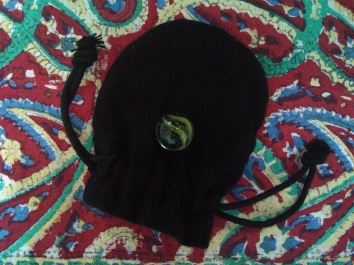In an earlier post I examined the links between cotton trees and Myal rituals. Now I’m going to be looking a bit more at the Myal faith, focussing on some aspects of its form and practice in the early twentieth century, the time when Martha Warren Beckwith was doing her Jamaican fieldwork.
Myal’s Origins
Myal is one of a number of African-Jamaican folk religions which blend, to varying degrees, aspects of Christianity with elements derived from African religions and spiritual belief systems. Martha Beckwith thought that Myal was of “directly African” origins. However, a more modern viewpoint, such as that expressed by Monica Schuler in her essay, ”Myalism and the African Religious Tradition”, places its development in Jamaica instead. The first written record of Myal in Jamaica appears in the 1760s but it’s most likely it had been in existence for some time before that. Central to Myal was the idea that humans possessed two types of spirits, the shadow and the duppy.
A ritual dance was performed to call the spirits down to the Myal ceremony. As I mentioned in my previous post on Death-weed an early account of the dance mentions initiates being put into a trance state. Having undergone this experience it was believed that the initiate would be protected from white men’s bullets.
As well as the propitiation of the spirit world, Myalists also located buried Obeah and restored spirits stolen by Obeah practitioners.
 Beckwith was told that an amber bead was used as a Myal talisman but that in Lacovia a glass marble was now used
Beckwith was told that an amber bead was used as a Myal talisman but that in Lacovia a glass marble was now used
Myal in early 20th century Jamaica
Through speaking with a Myalist leader and from information given to her from her African-Jamaican interviewees, Martha Beckwith gives us some idea about Myal beliefs and practices in early twentieth-century Jamaica. For example, one woman, a member of a Myalist group in Portland, told her that there was a distinction between two types of Myalist. The first type held communal ceremonies to summon the spirits. The second type worked in a solitary fashion by cotton trees.
Another Myalist told Beckwith that the spirits called up during the Myal dance manifested themselves at night and would be visible only to Myalists. A drum such as the gombay was used during the dance to draw the spirits into the proceedings.
One of Beckwith’s interviewees, the Lacovian Myal man James White, said that during the dance, the spirits, or ‘Deaths’, would present the Myalists with a talisman which would enable them to see where Obeah had been buried or shadows hidden (see picture). White also said that spirits would enable the “Myal-man” to perform “astonishing feats of climbing” such as clambering to the top of tall trees.
Despite Beckwith interviewing a number of Myalists during her fieldwork in the 1920s, there was some dispute amongst some early twentieth-century ethnographers and commentators on African-Jamaican religions about whether Myal was still practised. For example, in his book Twentieth Century Jamaica (1913), Herbert De Lisser argued that ‘Myal’ no longer existed as a term, having been replaced instead by the word ‘Revivalist’. However, others acknowledged that it was still in existence. In 1916, the ethnographer Abraham Emerick noted that even though Myal was not often referred to, Myalists were still following their faith. Although the American anthropologist, Joseph John Williams, believed that Myal had largely died out since the advent of Revival in the 1860s, he concurred with Emerick’s view that it was still present in Jamaica.
Nevertheless, by the late 1940s, a decade after Williams’ comment, Madelaine Kerr, a social psychologist to the West Indian Social Survey, found that in the rural areas where she gathered her data, ‘Myal’ was only ever used to describe a kind of spiritual trance.
Next time…. it’s across the Atlantic to look at the occult lore which surrounds Nightshade in Britain.
Sources (in order of first appearance in the text)
Martha Warren Beckwith, Black Roadways: A Study of Jamaica Folk Life (reprint, New York: Negro Universities Press, 1969, of orig. edn, Chapel Hill: University of North Carolina Press, 1929), p. 142, 147, 148, p. 144.
Monica Schuler, “Myalism and the African Religious Tradition” in Margaret E. Crahan and Franklin W. Knight, (eds) Africa and the Caribbean: The Legacies of a Link (Baltimore: Johns Hopkins University Press, 1979), pp. 65-79, p. 66
Monica Schuler, Alas, Alas, Kongo”: A Social History of Indentured African Immigration into Jamaica, 1841–1865, p. 32
Martha Warren Beckwith, “Jamaica Ethnobotany” in Martha Warren Beckwith, with music recorded in the field by Helen H. Roberts, Jamaica Folklore (New York: The American Folk-Lore Society, 1928), p. 52.
Herbert G. De Lisser, Twentieth Century Jamaica (Kingston: The Jamaica Times Ltd., 1913), p. 134.
Abraham Emerick, “Jamaica Mialism”, The Woodstock Letters: A Record of Current Events and Historical Notes Connected with the Colleges and Missions of the Society of Jesus, vol. XLV, (1916), p. 42.
Joseph John Williams, Voodoos and Obeahs: Phases of West Indian Witchcraft (reprint, Whitefish: Kessinger Publishing, date unknown, of orig. edn, New York: L. MacVeagh, Dial Press, inc., 1932), p. 215.
Madeline Kerr, Personality and Conflict in Jamaica (London and Jamaica: Collins; Sangster’s Book Stores, 1963), p. 213.
Image credits: photograph by H.R. Sparkes